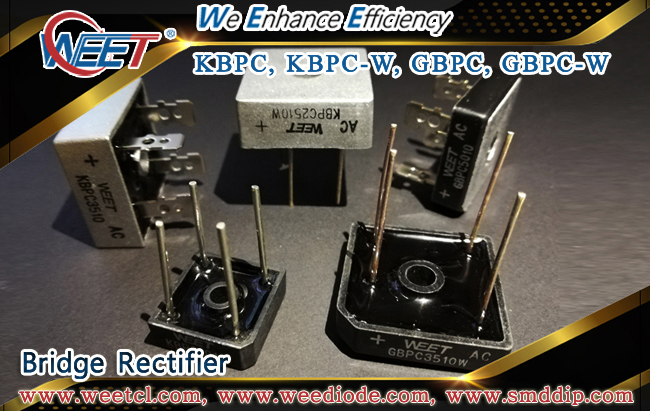-
WEET Square 3 Phase Bridge Rectifiers Zinc Shell KBPC and Plastic Shell GBPC Difference
Author: admin Publish: 2020/1/7 Category: Bridge Rectifiers Read: Times Comments

WEE Technology Company Limited
Manufacturer of Surface Mount (SMD) and Through Hole (DIP) Diodes & Rectifiers
WEET Square 3 Phase Bridge Rectifiers (Single Phase Square Type)Zinc Shell KBPC and Plastic Shell GBPC Difference.
WEET Bridge Rectifiers devices are provided in a variety of packages including SMD, Dual In-Line, Single In-Line, Square Type, Round Type, and 3 Phase Bridge Rectifiers.
https://www.weetcl.com/Single_Phase_Bridge_Rectifiers/WEET_KBPC35005_THUR_KBPC3510.html
https://www.weetcl.com/Single_Phase_Bridge_Rectifiers/WEET_GBPC35005W_THUR_GBPC3510W.html
GBPC3510-New package aluminum bottom plastic Shell - More stable and reliable
GBPC3510 uses a new aluminum bottom plastic case package. This new package is very different from the metal zinc case used by KBPC3510, which has better heat dissipation and stability. Customers who have used metal zinc shell packages will feel this way. The heat dissipation is relatively not prominent. The large amount of thermal energy accumulated in the long-term operation of the internal chip cannot be effectively exported, which directly affects the reliability of the bridge stack. The GBPC3510 is packaged in a new aluminum bottom plastic case. Aluminum has a high conduction efficiency and can conduct heat quickly, which greatly improves the reliability of the power supply.
GBPC5010 adopts aluminum bottom plastic Shell - Better protect chip and more secure
We know that GBPC3510 is a semiconductor power device, and the chip will heat up when it is working. Because the chip is wrapped with epoxy resin, the resin will expand slightly when the chip heats up, and when the rectifier bridge stops working, the resin will shrink slightly. Because the thermal equilibrium point of metal zinc and epoxy resin is not consistent, if the resin and the shell are not synchronized when the heat rises and contracts, it will cause a hard strain on the chip. Although this hard change is not great for the entire rectifier bridge, it is enough for the built-in chip to damage the chip. The GBPC3510 special design will be able to prevent the risk of wonderful chip is hard force injury, it can be more good to protect the chip from being damaged.
GBPC3510 with aluminum bottom plastic Shell - Thinner Volume
GBPC3510 uses the GPP passivation process for gold-plating large chips. The GPP passivation process is also called the glass passivation process. It is a layer of glass protection on the surface of the chip, which can better prevent chip oxidation and improve chip stability. The highlight is that it can reduce the thickness of the chip, which is in sharp contrast to the thick white glue wrapped with traditional pickled chips. Therefore, using a thinner GPP chip can make the GBPC3510 have a thinner volume.
Advantages and disadvantages of square rectifier bridge zinc shell and aluminum bottom plastic shell:
The galvanized shell rectifier bridge has a metal zinc envelope inside and a potted black plastic seal inside. The square bridge with this packaging method has lower cost and can be well applied in some places where the temperature rise is not high. However, the heat dissipation performance of this kind of bridge stack is not as good as the bridge stack of aluminum bottom plastic shell. On the contrary, the bridge stack of aluminum bottom plastic shell has a cooling aluminum plate under the square bridge stack, which can greatly improve the heat dissipation performance of the bridge stack. But relatively speaking, its cost will be higher, and the cost issue will be considered in our actual application.

Original Article From WEE Technology!Tags: WEET Square Bridge Rectifiers WEET Zinc Rectifiers KBPC3510 Zinc Bridge GBPC3510 Plastic Bridge Rectifers

- WEET Calender
- WEET Products Catalog
-
- WEET Previous
-
- WEET Control Panel
-

Comment: